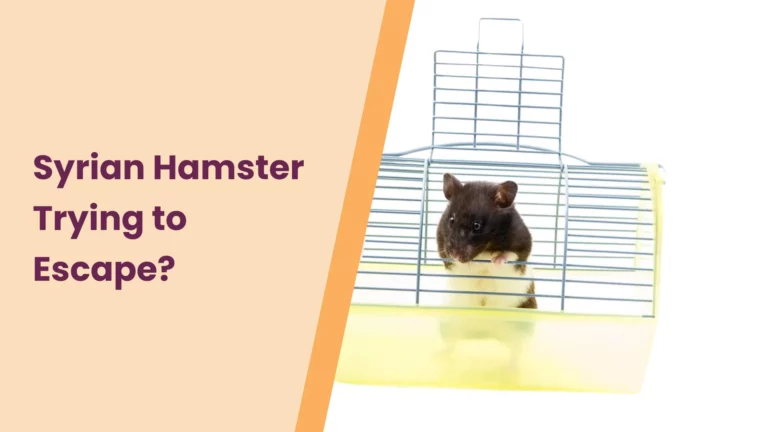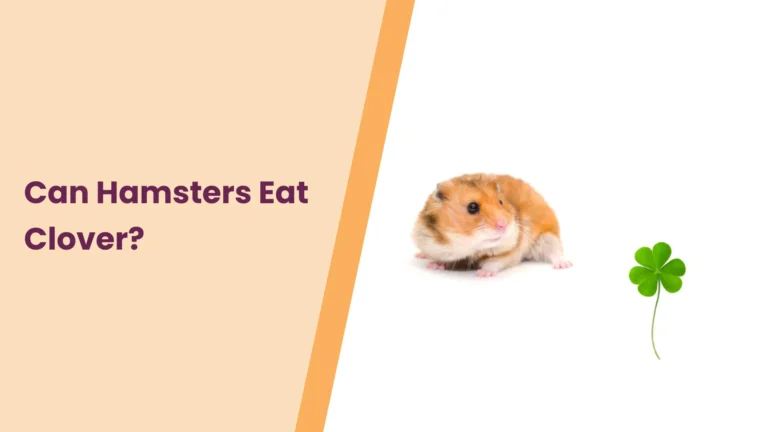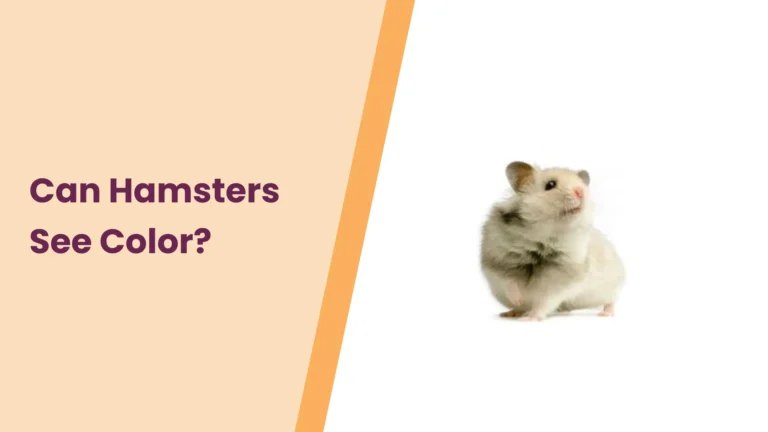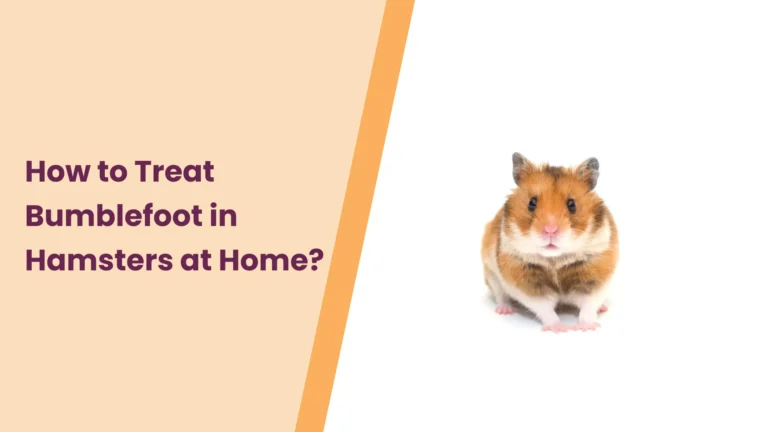What Colors Do Hamsters See? – All You Need To Know
Have you ever wondered how the world looks through the eyes of your furry, whisker-twitching companion? Hamsters, with their adorable antics and inquisitive nature, often capture our hearts. But what about their vision? What colors do hamsters see, and how does their unique perspective influence their daily lives?
In this journey into the enchanting realm of hamster care, we’ll unveil the secrets behind your pet’s eyes, exploring the fascinating world of hamster vision. From their preference for hues to the science that powers their night-time adventures.
Let’s unravel the captivating story of how hamsters perceive colors and how you can make their world even more delightful. Get ready to see through the eyes of your hamster and enhance their well-being in ways you never imagined!
What Colors Do Hamsters See? A Guide to Hamster Vision
Hamsters, those pint-sized bundles of fur and energy, navigate their world with a unique perspective. Unlike humans, whose eyes perceive a vast spectrum of colors, hamsters are dichromatic, meaning they see the world through a more limited color palette. But what does this actually mean for your hamster’s day-to-day life?
Understanding Hamster Color Vision
Imagine a world painted in shades of green and blue. This is essentially the hamster’s view. Hamsters are known to be dichromatic, which means they primarily perceive these two colors. While the exact range and depth of colors they can see may vary among different hamster species, their vision revolves around these hues. This limited color spectrum has a significant impact on how they interpret their surroundings.
Exploring Rod Cells and Cone Cells
To understand hamster color vision, it’s crucial to delve into the science of their eyes. Hamsters have both rod cells and cone cells in their retinas, much like humans. Rod cells are responsible for low-light and night vision, making hamsters incredibly adept at seeing in the dark. This skill is essential for their survival, as hamsters are nocturnal creatures.
Cone cells, on the other hand, are the key players in color vision. Hamsters, like many other animals, have fewer cone cells than humans. This reduced number of cones restricts the range of colors they can perceive, mainly limited to various shades of green and blue.
The Nighttime Advantage
One fascinating aspect of hamster vision is their night vision. Thanks to their abundance of rod cells, hamsters can see exceptionally well in low-light conditions. This adaptation is vital for their survival in the wild, where they’re most active during the night. In captivity, this exceptional night vision can lead to captivating behaviors.
Hamsters often become more active and playful during the night, making late-night observation sessions a delightful experience for pet owners. Understanding their night vision can help you appreciate these charming nighttime antics.
What This Means for Hamster Owners
As a responsible hamster owner, it’s essential to consider your pet’s unique vision when creating their habitat. Choosing the right colors for their cage accessories, toys, and bedding can make a significant difference in their comfort and well-being. Hamsters tend to see shades of green and blue more vividly, so incorporating these colors into their environment can make their surroundings visually stimulating.
On the other hand, it’s wise to avoid colors that hamsters might struggle to distinguish. While they can’t see the full spectrum of colors like humans, they certainly appreciate the world in their own unique way.
Rod Cells vs. Cone Cells: The Secrets of Hamster Vision
To truly appreciate the world through your hamster’s eyes, it’s essential to dive into the inner workings of their vision. Hamsters, like many creatures, have a unique arrangement of rod cells and cone cells in their eyes, and these cells play a pivotal role in shaping their perception of the world around them.
Rod Cells: The Nighttime Pioneers
Rod cells are the unsung heroes of your hamster’s vision, especially when the sun dips below the horizon. These specialized cells are responsible for low-light and night vision, making hamsters truly nocturnal experts. With a surplus of rod cells in their retinas, hamsters can see remarkably well in dim or even pitch-black conditions.
This night vision adaptation is not just a nifty party trick but an essential survival tool. In the wild, hamsters come alive after dark, foraging and exploring while staying alert for potential threats. The abundance of rod cells enables them to navigate their environment skillfully and find food, all while avoiding predators lurking in the shadows.
The Role of Cone Cells
Cone cells, on the other hand, handle the colorful side of your hamster’s world. These cells are akin to the palette on which they paint their limited color spectrum. While hamsters have fewer cone cells compared to humans, these cells still allow them to see a range of colors, mainly focusing on shades of green and blue.
Think of cone cells as the brushes that provide hints of vibrancy in the predominantly monochromatic world of a hamster. Their ability to perceive colors, even if in a reduced capacity compared to us, still enriches their experience of their surroundings.
Understanding the Balance
While rod cells and cone cells each have their specialized roles, they work together to create a holistic picture of the world for your hamster. This dynamic duo allows your pet to thrive in a diverse range of environments, whether it’s the dimly lit corners of their burrows, the darkened tunnels of a hamster wheel, or the twinkling glow of moonlight on their nocturnal adventures.
This unique arrangement of rod and cone cells is what sets hamster vision apart, making it a compelling subject for those who are fascinated by the intricacies of nature.
As a hamster owner, it’s valuable to be aware of this delicate balance between rod cells and cone cells in your pet’s eyes. It sheds light on why they exhibit certain behaviors, like their nightly escapades, and it highlights the importance of creating a safe and visually stimulating environment in their enclosure.
Hamster Vision in Low Light: Embracing the Nighttime World
Picture this: It’s the middle of the night, and your hamster is on an adventure, exploring its enclosure, running on its wheel, or even enjoying a midnight snack. How can they navigate their surroundings so adeptly in the dark? The secret lies in their remarkable ability to see in low-light conditions.
The Nocturnal Advantage
Hamsters are renowned for their nocturnal nature, which means they’re most active during the nighttime hours. This adaptation is partly due to their excellent night vision, a feature that sets them apart from diurnal animals. Their eyes are equipped with a surplus of rod cells, specialized photoreceptor cells that excel in low-light settings.
These rod cells grant hamsters a unique superpower – the ability to see remarkably well in conditions that would leave humans fumbling in the dark. As your hamster ventures out under the veil of night, it can pick up on details, navigate obstacles, and find its way with surprising ease.
Understanding Nighttime Behaviors
As a hamster owner, you’ve likely noticed that your pet becomes more active and lively when the sun sets. This is the time when their inherent night vision comes into play, allowing them to engage in activities that might otherwise be challenging during daylight hours.
Their nightly escapades are fascinating to observe, and understanding the role of their night vision can deepen your appreciation of their nocturnal habits.
Enhancing the Nocturnal Experience
To create an environment that truly caters to your hamster’s nocturnal tendencies, consider a few key elements. First, provide hiding spots and tunnels to mimic their natural burrowing instincts. This allows them to feel safe and secure as they explore in the dark.
Second, incorporate items like exercise wheels and interactive toys to keep them engaged during their nighttime adventures. The stimulation provided by these activities can be a source of both physical exercise and mental enrichment.
Lastly, when selecting cage accessories and toys, opt for colors that are visible in low light, such as various shades of green and blue. This enhances their overall experience and makes their nighttime world even more intriguing. Understanding and embracing your hamster’s nighttime world is not only a testament to their remarkable adaptation but also a chance to bond with your pet during those captivating midnight hours.
Colors to Use and Avoid in Hamster Care: Creating a Vibrant Habitat
As a conscientious hamster owner, one of the delightful ways to enrich your pet’s life is by thoughtfully designing their living space. Color plays a significant role in this aspect, affecting your hamster’s visual experience and overall well-being. But what colors do hamsters see, and how can you use this knowledge to create a vibrant and visually stimulating environment?
Preferred Colors for Hamsters
Understanding your hamster’s limited but fascinating dichromatic vision is the first step. Hamsters primarily see shades of green and blue. These colors stand out more prominently in their world, so it’s wise to incorporate them into their habitat. Toys, cage accessories, and even bedding in these hues can captivate your hamster’s attention and create a visually engaging space.
When you add touches of green and blue to their surroundings, you’re essentially painting a more vivid landscape for them to explore. It’s akin to filling their world with the colors they find most appealing, which can contribute to their overall contentment.
Colors to Avoid
While the dominant colors in a hamster’s world are green and blue, it’s essential to consider their limitations. They may struggle to distinguish between certain colors, such as reds and yellows. These colors can appear as varying shades of gray to your hamster, making them less visually appealing and potentially even confusing.
Thus, it’s advisable to steer clear of using predominantly red or yellow items in your hamster’s habitat, as they may not provide the visual stimulation you intend. Instead, opt for the shades that align with their natural preferences.
Creating a Colorful and Safe Space
A well-designed hamster habitat incorporates a balance of colors, shapes, and textures. To enhance your hamster’s experience, consider adding a variety of greens and blues, whether it’s through colorful toys, bedding, or even the hamster’s surroundings. The combination of visual and tactile stimulation can keep your pet entertained and engaged.
It’s also worth remembering that hamsters are known for their keen sense of smell and their ability to navigate using scent and texture. So, while colors are essential, don’t underestimate the significance of scent and touch in their world.
By creating a colorful and textured space, you’re providing a multisensory experience that caters to your hamster’s unique abilities and instincts.
The Role of Scent and Texture: Navigating the Hamster’s World
When it comes to understanding hamster care, it’s not just about what your pet can see; it’s about what they can smell and feel. Hamsters are sensory creatures, and their world is intricately shaped by scent and texture. While we’ve explored the colors they can perceive, it’s equally essential to delve into these often-overlooked dimensions of their existence.
The Importance of Scent
Hamsters have a remarkable sense of smell, allowing them to detect and identify scents with astonishing precision. In their natural habitat, this acute sense of smell serves them well, helping them locate food, communicate with other hamsters, and navigate their environment. As a hamster owner, you can harness this natural instinct by introducing various scents into your pet’s environment.
You might consider adding bedding materials with distinctive aromas or providing fresh herbs for them to nibble on. This not only engages their sense of smell but also provides mental stimulation, a vital aspect of their overall well-being.
Textures and Comfort
Texture plays an equally crucial role in your hamster’s world. Unlike humans, who rely heavily on sight, hamsters rely on touch and texture to interact with their surroundings. Their sensitive whiskers and paws allow them to explore their habitat in intricate detail.
Creating a habitat that offers a variety of textures can be enriching for your pet. This can include cozy bedding, tunnels with different surfaces, and toys with various textures to chew and explore. Such a diverse environment appeals to their natural instincts, encourages playfulness, and provides comfort. This will also help your hamster to manage stress effectively.
The Multisensory Experience
As you design your hamster’s habitat, remember that it’s not just about individual sensory experiences; it’s about creating a harmonious multisensory world. A combination of colors, textures, and scents makes for a compelling and engaging environment. For instance, you might introduce a soft, scented nesting material in a specific part of the cage. This provides a cozy and aromatic space for your hamster to rest and sleep.
Meanwhile, textured chew toys can keep them engaged and promote dental health. The interplay of these elements contributes to a well-rounded and stimulating home for your pet. In essence, embracing the sensory world of your hamster goes beyond visuals. It’s about immersing them in an environment that caters to their innate abilities, making their life not just colorful but rich and fulfilling in every sense.
Conclusion
In the enchanting world of hamster care, we’ve embarked on a journey through your pet’s unique perspective. As we’ve explored what colors hamsters see, the secrets of their dichromatic vision have unfolded, revealing the captivating shades of green and blue that fill their world. The delicate balance between rod cells and cone cells, their exceptional night vision, and their engaging nocturnal behaviors have added to the tapestry of their lives.
We’ve learned the significance of color in designing their habitat—how incorporating their preferred hues of green and blue can stimulate their visual senses. Equally vital is understanding the role of scent and texture, harnessing their heightened sense of smell and their reliance on touch to create a harmonious and multisensory environment. By embracing your hamster’s unique sensory experience, you’re not merely caring for a pet; you’re nurturing a fascinating, vibrant, and thriving world.
As a responsible hamster owner, you have the power to enhance their well-being by offering a thoughtful, colorful, and engaging space where they can be the vibrant little explorers they’re meant to be.
So, when you look into those bright, beady eyes of your hamster, know that you’re peeking into a world of color, scent, and texture, all of which combine to create a life as enriching as it is colorful. With this newfound knowledge, you’re well-equipped to provide the care and comfort your beloved hamster deserves.
“We’re thrilled to have taken you on this intriguing journey into the world of hamster vision and sensory experiences. Your thoughts and experiences matter, and we’d love to hear from you. Have you observed unique behaviors in your own hamster that align with what we’ve explored?
Do you have tips or anecdotes that could further enrich our understanding of these endearing pets? Feel free to drop a comment below and share your thoughts or questions. Your contributions can be a valuable addition to the vibrant hamster-loving community. And, if you found this exploration of hamster care enlightening, why not share it with fellow hamster enthusiasts?
By clicking those share buttons, you’re not only spreading knowledge but also fostering a sense of togetherness among pet owners. Whether it’s Facebook, Twitter, or other social platforms, your share might just brighten another hamster lover’s day and offer fresh insights. Let’s continue learning, sharing, and creating a community that celebrates the fascinating world of hamsters.” – Hamsterpit.







